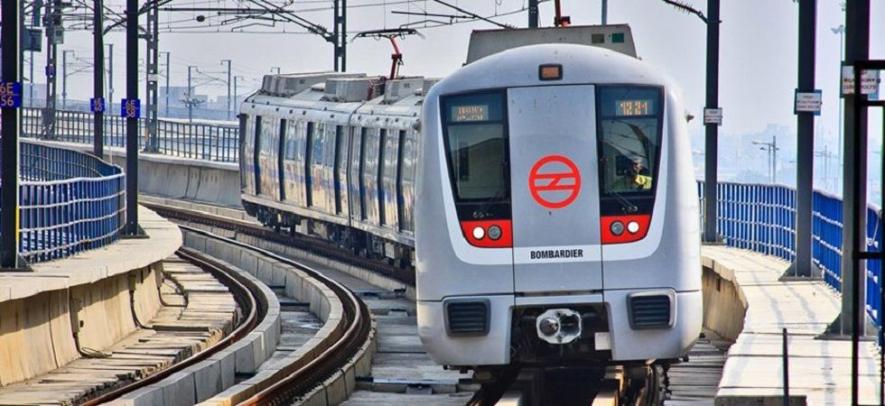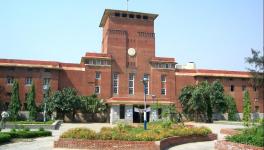Free Rides for Delhi Women Will Make Work and Education More Accessible

Image Courtesy: News Nation
It has been a few days since Chief Minister Arvind Kejriwal announced that travel in Delhi Metro and in public buses will be made free for women. The announcement, that has on one hand been hailed by working class women, has, on the other hand, faced heavy flak from the middle-class population of Delhi.
The Delhi Metro Rail Corporation (DMRC) is reported to have lost around three lakh commuters after the metro fare hike in Delhi. Being one of the largest metro networks in the world, the Delhi Metro network consists of about 373 km with 271 stations. It is definitely one of the most convenient modes of public transportation in the city, connecting the centre of the city to outskirts like Ghaziabad, Faridabad, Bahadurgarh, Ballabhgarh, and Greater Noida.
The fare hikes had an adverse effect on the working-class population in Delhi. The workers who used to take the metro to their workplaces on a regular basis started opting for cheaper modes of transport, like public buses and shared autos, even if it sometimes meant changing three buses to reach their destination across the city. And among the working-class population, the worst affected section was that consisting of working women, because for them using cheaper modes of transport also meant having to compromise on their safety.
Also watch: What are Implications of Metro Fare Hike on the City's Systems?
According to a study published in December 2017 by Institute for Transportation and Development Policy, most cases of sexual harassment in public transport go unreported in India. The study also pointed out that women are more affected than men when access to employment, education or basic services are located far away from their residences. Another paper, Safety First: Perceived Risk of Street Harassment and Educational Choices of Women, written by Brown University PhD scholar Girija Borker, found that sexual harassment cost women their economic mobility in Delhi.
According to a report by the Institute for Human Development (IHD), the Female Labour Force Participation Rate in Delhi in 2011-2012 was 11%, as compared to the national average of 25.1%. According to the Delhi Human Development Report – 2013: Improving Livelihoods and Bridging Disparities, also published by IHD, there was a stark difference between the average salaries of male and female casual workers in Delhi. In 2011-2012, women earned only Rs 98 per day, while male casual workers earned an average of Rs 265 per day.
Hence, if this scheme is implemented, it would make public transportation more accessible for women, and as a result, increase their access to employment, education, healthcare, and other basic necessities. Talking about the necessity of this scheme, Atishi, the Aam Aadmi Party (AAP) leader said in a Facebook post, “The fare hike last year hit women the worst forcing them to shift to more unsafe modes of transport like private buses, ride sharing, or even walking. This move will help them return to the Metro's safety. More women in any public spaces automatically makes those spaces safer for women. This move will help women reclaim public spaces.”
Also read: Delhi Not Safe For Women And Children Amid Spurt in Crime Rate, Finds Survey
She also added, “Men may also need financial assistance; however, men have other alternatives that don’t compromise their safety. For example, men have the option of taking two wheelers to work or using ride sharing apps without concern for their safety.”
CM Arvind Kejriwal has said that the ticket revenue lost by DMRC in lieu of this scheme will be fully reimbursed by the Delhi Government. He has also denied the speculation that this move might result in overcrowding in the Metro, saying that only 25 lakh commuters are using the metro, while the capacity of Delhi Metro is a ridership of 40 lakh daily.
The reaction to this announcement has made the class divide visible between the people who are for and against it. A lot of middle-class women have opposed to move, saying that this is not a sign of empowerment. Srishti Pandey, a MBBS student, said, “But if you're getting everything for free, there's no point in making money or doing a job. Your male colleague who is earning equally, making the same amount of money, is paying for his fares while you on the other side aren't.”
What remains ignored in statements like above is the fact that women are not earning the same amount as their male colleagues in most cases, especially the casual workers and daily wage labourers. Also, across families from all classes, women constitute the section that puts in most amount of unpaid labour. More often than not, they are the first ones to wake up in a family, the last ones to eat, and last one to go to bed. While talking about class hierarchy, the position of working-class women comes below that of working-class men. They continue to remain one of the most oppressed sections of the society.
While making public transportation free for women might not be the perfect move, and might not immediately make public transportation safer for women, it will definitely encourage more women to step into the public sphere and reclaim their space.
Get the latest reports & analysis with people's perspective on Protests, movements & deep analytical videos, discussions of the current affairs in your Telegram app. Subscribe to NewsClick's Telegram channel & get Real-Time updates on stories, as they get published on our website.






















